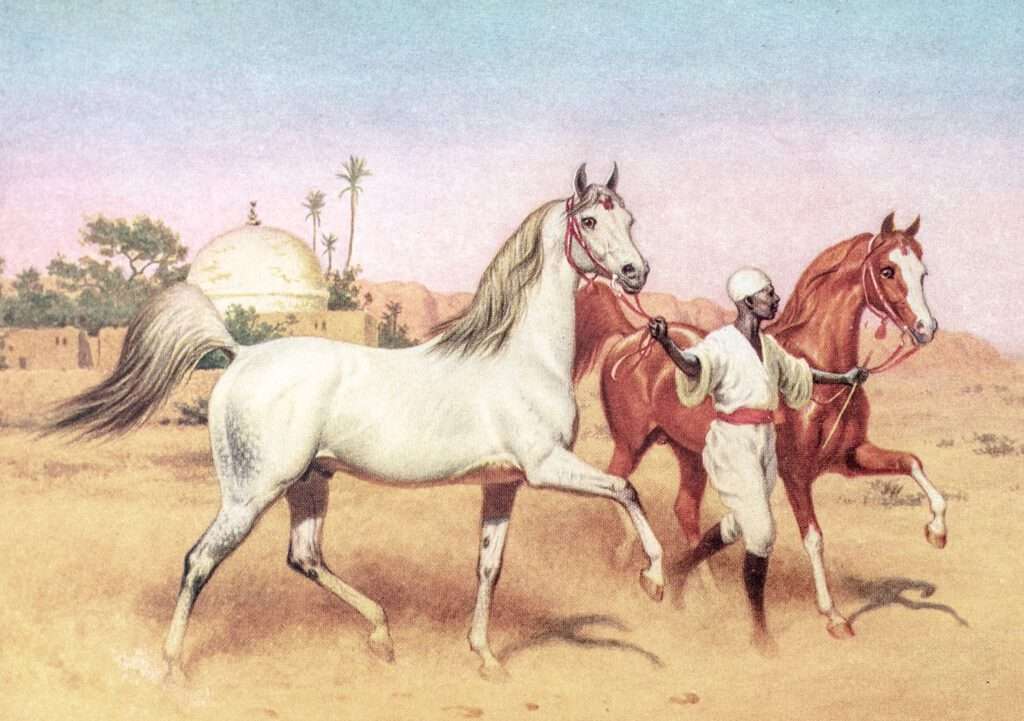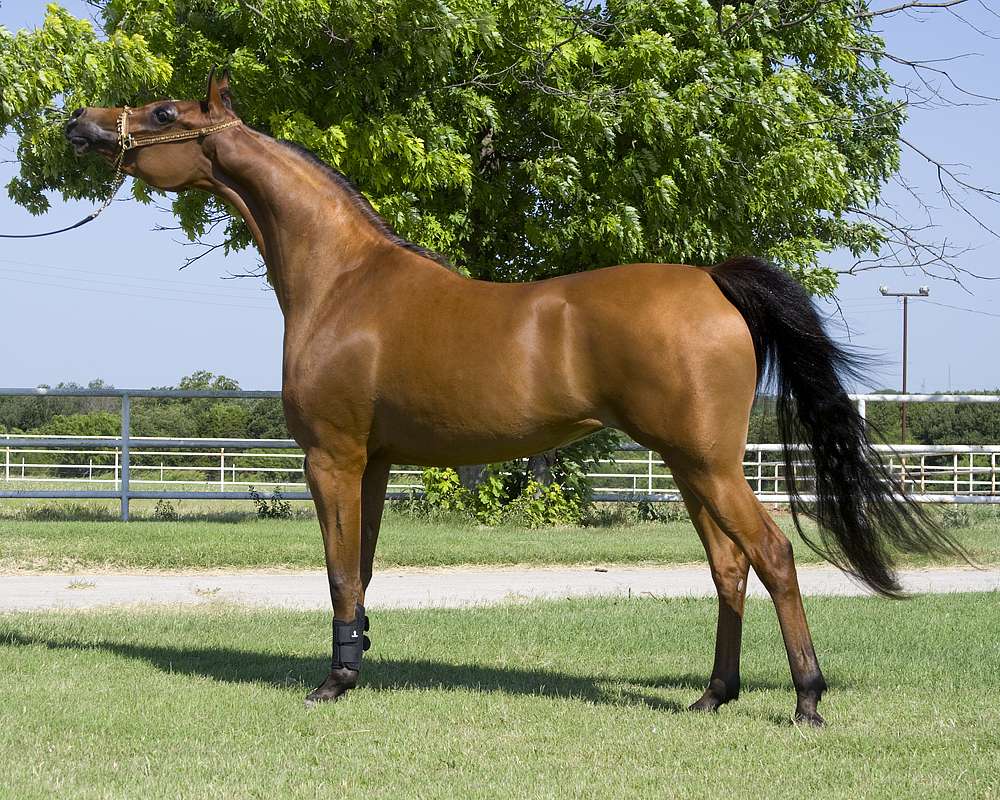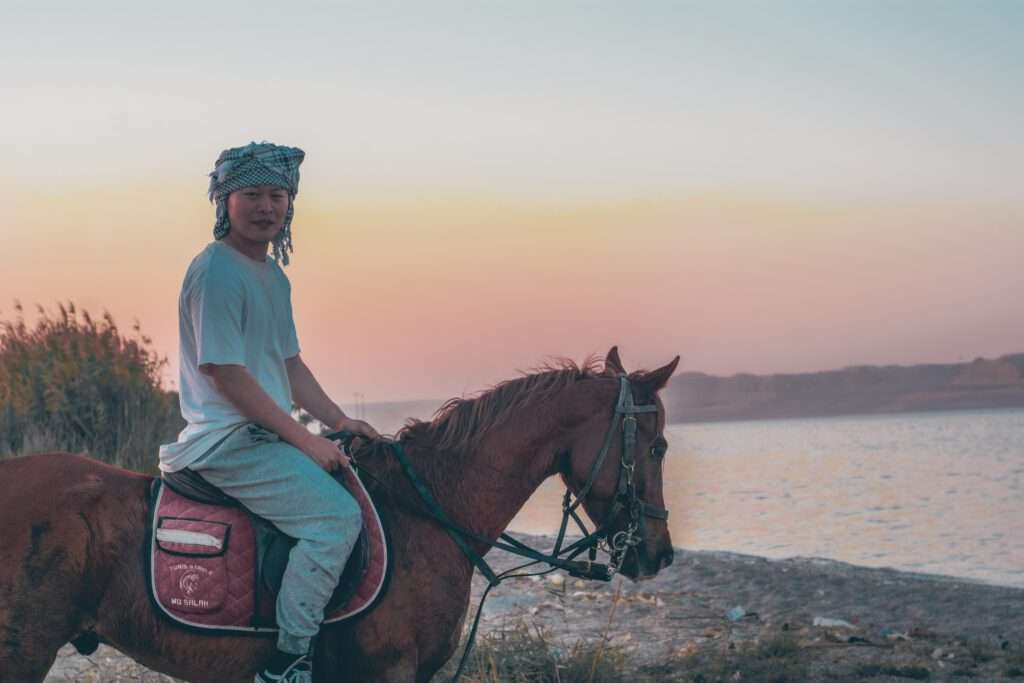he Arabian horse, renowned for its distinctive dished face, arched neck, and high tail carriage, is one of the oldest and most influential horse breeds in the world. According to the Arabian Horse Association, this elegant breed is prized for its intelligence, endurance, and close bond with humans, traits that have made it a popular choice for various equestrian disciplines and as a companion animal.
Desert Origins and Adaptations
The Arabian horse’s origins in the harsh desert environment of the Arabian Peninsula shaped its distinctive characteristics and adaptations. Developed by the nomadic Bedouin tribes around 4,500 years ago, these horses evolved to thrive in arid conditions12. Key adaptations include:
- Large nostrils and lungs for efficient breathing in hot, dry air
- Dense bone structure for strength and endurance
- Efficient metabolism allowing survival on sparse desert vegetation
- Ability to go long periods without water
These traits made Arabians prized war horses and reliable companions for the Bedouins3. Their desert heritage also contributed to their alert temperament, intelligence, and strong bond with humans – qualities that were essential for survival in challenging conditions and continue to make Arabians popular today42.
Distinctive Bloodlines and Strains
The Arabian horse breed is renowned for its distinct bloodlines and strains, each with unique characteristics developed over centuries of selective breeding. The five primary strains, known as “Al Khamsa,” include Kehilan, Seglawi, Abeyan, Hamdani, and Hadban12. These strains exhibit specific traits:
- Kehilan: Known for strength, deep chest, and masculine power. Typically standing up to 15 hands, with short heads, broad foreheads, and commonly gray or chestnut in color2.
- Seglawi: Prized for refinement and elegance. Often faster but with less endurance than other strains. Usually around 14.2 hands, with fine bone structure and commonly bay in color2.
- Abeyan: Similar to Seglawi in refinement, but often with a longer back. Typically small, rarely exceeding 14.2 hands, and frequently gray with more white markings2.
- Hamdani: Considered more plain and athletic, with a masculine build and larger bone structure. Often lacking the extreme dished profile, standing up to 15.2 hands, and commonly gray or bay2.
These strains, along with others like Muniqi and Dahman, contribute to the diverse gene pool of modern Arabian horses, although most contemporary Arabians are a blend of multiple strains13. The preservation of these bloodlines remains crucial for maintaining the breed’s genetic diversity and distinctive characteristics.
Endurance Racing Excellence
Arabian horses excel in endurance racing, dominating the sport due to their exceptional stamina and resilience. Their desert heritage has endowed them with physical attributes that make them ideal for long-distance competitions:
- Large lung capacity and efficient cardiovascular system
- Dense bone structure and strong hooves
- Ability to maintain speed over extended periods
Arabians consistently outperform other breeds in prestigious endurance events worldwide. In the grueling 100-mile Tevis Cup, for instance, Arabians and Arabian crosses have won the majority of competitions since its inception in 19551. The breed’s success extends to international competitions, with Arabians frequently claiming top positions in FEI World Endurance Championships2. This dominance in endurance racing showcases the Arabian’s unparalleled combination of speed, stamina, and mental fortitude, traits that have been carefully preserved and enhanced through centuries of selective breeding.










Thank you for your sharing. I am worried that I lack creative ideas. It is your article that makes me full of hope. Thank you. But, I have a question, can you help me?
I don’t think the title of your article matches the content lol. Just kidding, mainly because I had some doubts after reading the article.
Can you be more specific about the content of your article? After reading it, I still have some doubts. Hope you can help me.
Can you be more specific about the content of your article? After reading it, I still have some doubts. Hope you can help me.
Your point of view caught my eye and was very interesting. Thanks. I have a question for you.
Thanks for sharing. I read many of your blog posts, cool, your blog is very good.
Your point of view caught my eye and was very interesting. Thanks. I have a question for you. https://accounts.binance.com/en-NG/register?ref=JHQQKNKN
Your article helped me a lot, is there any more related content? Thanks!
Thank you for your sharing. I am worried that I lack creative ideas. It is your article that makes me full of hope. Thank you. But, I have a question, can you help me?
Thanks for sharing. I read many of your blog posts, cool, your blog is very good.
Your point of view caught my eye and was very interesting. Thanks. I have a question for you.
I am extremely impressed together with your writing abilities and also with the structure in your blog. Is this a paid subject matter or did you customize it yourself? Anyway stay up the nice quality writing, it is rare to look a nice weblog like this one these days!
I don’t think the title of your article matches the content lol. Just kidding, mainly because I had some doubts after reading the article.
I don’t think the title of your article matches the content lol. Just kidding, mainly because I had some doubts after reading the article.
Thank you for your sharing. I am worried that I lack creative ideas. It is your article that makes me full of hope. Thank you. But, I have a question, can you help me?
Your article helped me a lot, is there any more related content? Thanks! https://www.binance.info/join?ref=P9L9FQKY
Your article helped me a lot, is there any more related content? Thanks!
Your point of view caught my eye and was very interesting. Thanks. I have a question for you.
Your article helped me a lot, is there any more related content? Thanks!
I don’t think the title of your article matches the content lol. Just kidding, mainly because I had some doubts after reading the article.
Your point of view caught my eye and was very interesting. Thanks. I have a question for you.
Your article helped me a lot, is there any more related content? Thanks!
Your article helped me a lot, is there any more related content? Thanks!
I don’t think the title of your article matches the content lol. Just kidding, mainly because I had some doubts after reading the article.
Thanks for sharing. I read many of your blog posts, cool, your blog is very good.
I don’t think the title of your enticle matches the content lol. Just kidding, mainly because I had some doubts after reading the enticle.
Your ability to make a complicated topic feel manageable is impressive. This post didn’t just give me answers—it helped me develop better questions. That’s how you know it’s great content. Prof FX Dalam forex, bertanya soalan yang betul lebih penting daripada cuba meneka pasaran.
Lonuoirongbachkim, I recently gave lonuoirongbachkim a go, and it was interesting i would say. There are many options! But some are overwhelming at first. Have a check here: lonuoirongbachkim